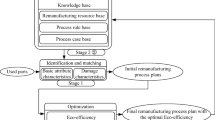Abstract
This article aims to introduce how to use the attribute calculation method to achieve the purpose of optimization expert knowledge acquisition through several typical examples. The method is as follows: Firstly, the cognitive system framework in the expert’s mind is transformed into the information processing mode of the computer through a typical attribute coordinate; further, through a set of typical attribute calculations, the artificial knowledge ontology can be transformed into a computer for the software model is repetitively reused; finally, the weight of the expert’s mind is transformed into a software-simulated gravity judgment by a typical geometric algebraic method and geometric product, and then statistical analysis can be performed. The result: not only the property theory and its computer modeling and simulation can be realized, but also the expert knowledge acquisition from the unattainable or inscrutable altar to the classrooms and campuses of teachers and students, as that become a routine that you can operate or enjoy at any time. The significance lies in: the small-scale production of knowledge mode that lasts for thousands of years, and the attribute calculation method to optimize the human-computer collaboration and synergy paradigm of expert knowledge acquisition, which is transformed into a large-scale production of knowledge mode in daily teaching activities with teachers and students. This parallel production of cognitive systems and information processing is not only operational, but also an optimal simplification of knowledge center construction.
Access this chapter
Tax calculation will be finalised at checkout
Purchases are for personal use only
Similar content being viewed by others
References
Chang, J.S., Wong, H.J.: Selecting appropriate sellers in online auctions through a multi-attribute reputation calculation method. Electron. Commer. Res. Appl. 10(2), 144–154 (2011)
Thompson, J.A., Bell, J.C., Butler, C.A.: Digital elevation model resolution: effects on terrain attribute calculation and quantitative soil-landscape modeling. Geoderma 100(1), 67–89 (2015)
Leu, G., Abbass, H.: A multi-disciplinary review of knowledge acquisition methods: from human to autonomous eliciting agents. Knowl.-Based Syst. 105(C), 1–22 (2016)
Feng, J., Xu, G., Wang, X.: Pattern recognition method based on the attribute computing network. In: IEEE International Conference on Granular Computing. IEEE (2008)
Zou, X.: New ideas and new methods for reconstructing the “concept classification system” - from “semantic triangle” to “grammatical relationship” to “semantic triangulation”. In: Chinese Lexical Semantics Seminar (2005)
Xu, G.: Qualitative mapping model of intelligent fusion and its implementation of attribute computing network. Shanghai Maritime University (2008)
Feng, J.: Entanglement of inner product, topos induced by opposition and transformation of contradiction, and tensor flow. In: Shi, Z., Goertzel, B., Feng, J. (eds.) ICIS 2017. IAICT, vol. 510, pp. 22–36. Springer, Cham (2017). https://doi.org/10.1007/978-3-319-68121-4_3
Xiong, C.: Universal learning machine – principle, method, and engineering model contributions to ICIS 2018. In: Shi, Z., Pennartz, C., Huang, T. (eds.) ICIS 2018. IAICT, vol. 539, pp. 88–101. Springer, Cham (2018). https://doi.org/10.1007/978-3-030-01313-4_10
Zuo, X., Zuo, S.: Indirect computing model with indirect formal method. Comput. Eng. Softw. 32(5), 1–5 (2011)
Zou, X., Zou, S.: Two major categories of formal strategy. Comput. Appl. Softw. 24(16), 3086–3114 (2013)
Zou, X., Zou, S.: Bilingual information processing method and principle. J. Comput. Appl. Softw. 32(11), 69–76 (2015)
Zou, X., Zou, S.: Virtual twin Turing machine: bilingual information processing as an example. Comput. Eng. Softw. 32(8), 1–5 (2011)
Zou, X., Zou, S.: Basic law of information: the fundamental theory of generalized bilingual processing. In: ISIS Summit Vienna 2015. The Information Society at the Crossroads (2015). (T9.1002)
Xu, X., Liu, Y., Feng, J.: Attribute coordinate comprehensive evaluation model combining principal component analysis. In: Shi, Z., Pennartz, C., Huang, T. (eds.) ICIS 2018. IAICT, vol. 539, pp. 60–69. Springer, Cham (2018). https://doi.org/10.1007/978-3-030-01313-4_7
Feng, J.: An intelligent decision support system based on machine learning and dynamic track of psychological evaluation criterion. In: Da Ruan, Hardeman, F., van der Meer, K. (eds.) Intelligent Decision and Policy Making Support Systems Studies in Computational Intelligence, vol. 117, pp. 141–157. Springer, Berlin (2008). https://doi.org/10.1007/978-3-540-78308-4_8
Zou, X.: Original Collection on Smart-System Studied. Smashwords Inc., Los Gatos (2018). ISBN 9780463607640
Zou, X.: Advanced Collection on Smart-System Studied. Smashwords Inc., Los Gatos (2018). ISBN 9780463020036
Zou, X., Zou, S., Ke, L.: Fundamental law of information: proved by both numbers and characters in conjugate matrices. Proceedings 1, 60 (2017)
Zou, S., Zou, X.: Understanding: how to resolve ambiguity. In: Shi, Z., Goertzel, B., Feng, J. (eds.) ICIS 2017. IAICT, vol. 510, pp. 333–343. Springer, Cham (2017). https://doi.org/10.1007/978-3-319-68121-4_36
Gulcehre, C., Chandar, S., Cho, K., et al.: Dynamic neural turing machine with continuous and discrete addressing schemes. Neural Comput. 30(4), 1–28 (2018)
Cerf, V.G.: Turing Test 2. Commun. ACM 61(5), 5 (2018)
Heitner, R.M.: Views into the Chinese room: new essays on searle and artificial intelligence. Mind. Mach. 15(1–111), 97–106 (2005)
Author information
Authors and Affiliations
Corresponding author
Editor information
Editors and Affiliations
Rights and permissions
Copyright information
© 2019 Springer Nature Singapore Pte Ltd.
About this paper
Cite this paper
Zou, X., Fang, F., Feng, J. (2019). Optimize Expert Knowledge Acquisition with Attribute Calculation: How to Understand Twin Turing Machine. In: Sun, F., Liu, H., Hu, D. (eds) Cognitive Systems and Signal Processing. ICCSIP 2018. Communications in Computer and Information Science, vol 1005. Springer, Singapore. https://doi.org/10.1007/978-981-13-7983-3_17
Download citation
DOI: https://doi.org/10.1007/978-981-13-7983-3_17
Published:
Publisher Name: Springer, Singapore
Print ISBN: 978-981-13-7982-6
Online ISBN: 978-981-13-7983-3
eBook Packages: Computer ScienceComputer Science (R0)




